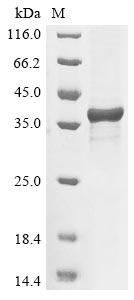Recombinant Brugia malayi tRNA (guanine-N(7)-)-methyltransferase (Bm1_01445) is expressed in E.coli, covering amino acids 1 to 258, and is provided as a full-length protein. It features an N-terminal 10xHis-tag for ease of purification and detection. The protein is purified to a level greater than 85% as determined by SDS-PAGE, ensuring a high-quality reagent suitable for various research applications.
tRNA (guanine-N(7)-)-methyltransferase is an enzyme involved in the post-transcriptional modification of tRNA molecules. This protein catalyzes the methylation of guanine bases, a critical step in tRNA maturation that influences the stability and function of tRNA. Studying this enzyme appears important for understanding the molecular mechanisms underlying RNA modification processes, which seem essential in the regulation of gene expression.
Potential Applications
Note: The applications listed below are based on what we know about this protein's biological functions, published research, and experience from experts in the field. However, we haven't fully tested all of these applications ourselves yet. We'd recommend running some preliminary tests first to make sure they work for your specific research goals.
The recombinant Brugia malayi tRNA (guanine-N(7)-)-methyltransferase expressed in yeast with an N-terminal 10×His tag represents the full-length enzyme, which greatly increases the likelihood of correct folding. Yeast expression systems are well-suited for soluble cytosolic enzymes such as methyltransferases, which do not depend heavily on post-translational modifications for activity. Moreover, methyltransferases are typically monomeric, globular enzymes that fold autonomously. However, since enzymatic activity has not been experimentally verified, its bioactivity remains presumptive. Validation using methyltransferase activity assays (e.g., SAM-dependent methyl transfer to tRNA) is recommended to confirm catalytic function.
1. In Vitro Enzymatic Activity Characterization
This recombinant tRNA methyltransferase can be used to study enzymatic activity and substrate specificity in vitro. It is suitable for biochemical assays measuring guanine-N(7)-methylation on tRNA substrates and for determining kinetic parameters such as Km and Vmax. If the enzyme is properly folded, it should exhibit catalytic activity consistent with native methyltransferase function. If misfolded or partially inactive, it can still be used for substrate binding or cofactor association studies, but quantitative kinetic results may not be reliable. Therefore, activity validation through SAM-dependent methyltransferase assays is essential before mechanistic interpretation.
2. Comparative Enzyme Studies Between Species
The recombinant B. malayi methyltransferase serves as a strong reference for cross-species comparisons among tRNA methyltransferases. Researchers can evaluate differences in substrate range, catalytic rates, and cofactor affinity between orthologs. If correctly folded, it enables meaningful comparative enzymology reflecting evolutionary divergence. If folding is uncertain, it can still be used for sequence and structure-based comparisons, but functional data must be interpreted with caution until enzymatic competence is confirmed.
3. Antibody Development and Validation
This His-tagged full-length methyltransferase is well suited for generating specific antibodies. The >85% purity supports its use as an immunogen in antibody production and validation assays. If folded correctly, the antigen will generate antibodies that recognize both native and recombinant enzyme. If misfolded, it can still be used to produce antibodies recognizing linear epitopes for use in ELISA or Western blotting, though they may not recognize the native conformation in immunostaining or immunoprecipitation assays. Thus, the recombinant protein remains a valid immunogen for antibody production.
4. Protein-Protein Interaction Studies
This recombinant methyltransferase can be used to identify interacting proteins or cofactors through pull-down or affinity-based assays. The N-terminal 10×His tag facilitates immobilization on nickel-affinity matrices for screening nematode lysates or recombinant libraries. If the protein retains native folding, such assays can reveal biologically relevant partners involved in RNA modification pathways. If misfolded, captured interactions may be nonspecific, so secondary validation (e.g., co-expression or co-immunoprecipitation) is needed to confirm physiological relevance.
5. Structural and Biophysical Analysis
This purified recombinant enzyme provides suitable material for biophysical and structural characterization (e.g., CD spectroscopy, DLS, DSC, or crystallization trials). If properly folded, it can be used for high-resolution structural studies such as X-ray crystallography or NMR to define catalytic residues and cofactor-binding sites. If partially misfolded, it still serves for low-resolution or stability analyses, but crystallographic success or NMR quality will be limited. Verification of homogeneity and folding is thus a prerequisite for advanced structural studies.






